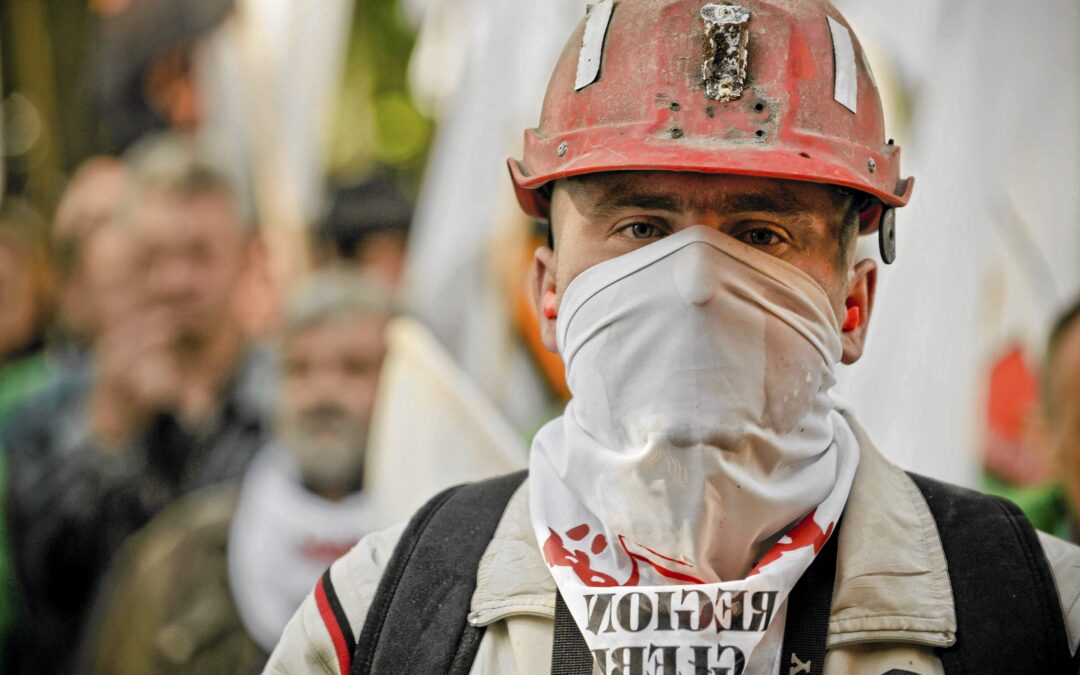By Jakub Wiech
Poland is the coal titan of the European Union. The country produces 90% of the EU’s hard coal and 16% of its lignite, according to last year’s figures. Some 90,000 people are employed in the Polish mining sector. Silesia – the oldest and largest mining region in Poland – is one of the last such operational areas in the EU.
The people working in the mines, along with their unions, also enjoy special status in Poland. Politicians have generally tried to stay in the good books of the mining community – not only to earn the electoral support of what is a large group of voters, but also to avoid incurring their wrath. Consecutive governments have made a habit of pandering to their interests.
During the last parliamentary elections in Poland in 2019, all major political parties included specific chapters in their manifestos dedicated to Silesia. Some argued outright that the area and its inhabitants have unique status, and thus should be exempt from green energy transition requirements.
In Poland’s response to the coronavirus pandemic, when the largest outbreaks in the country have taken place in mines, with more than 6,000 underground workers infected, miners have again been given special treatment. They were the only professional group in Poland to receive 100% wage compensation from the government while their workplaces were shut down.
And earlier this year, miners served a reminder of their clout when they organised vociferous demonstrations over imported Russian coal. Whereas strikes by other professions such as teachers and doctors – who are both far more numerous than miners – have been unsuccessful in recent years, the government approved a pay rise after miners agreed to call off a planned protest, having previously blocked train tracks and tipped bags of coal into the offices of their local MPs.
What is it about the mining lobby that makes it so strong? Why are politicians so ready to yield to their demands, despite evidence suggesting that this entrenched approach has a negative impact on the condition of the mining sector and Poland’s wider economic situation?
Carbon history
The special status of miners in Polish society stems from the political and economic framework into which Poland was inserted after 1945. After the Second World War, Poles found themselves in a new bind, this time from the communist authorities under the supervision of Moscow.
Official ideological doctrine emphasised the crucial importance of workers – including miners – for the nation’s prosperity and the creation of a new socialist society. State propaganda emphasised the contribution of those working in the mines, praising their hard work and commending the risks they were taking by working underground. The miner’s uniform and mine extraction towers became recognisable elements in socialist realist propaganda materials.
Guests arriving at the #COP24 UN climate change conference in Poland today were greeted in the lobby by a coal-miners band pic.twitter.com/XAPEjiZee8
— Notes from Poland 🇵🇱 (@notesfrompoland) December 3, 2018
However, the reputation of mining was also based on the economic strength of the sector. Hard coal mining was one of the most important mechanisms used to hoist the Polish economy out of the wreckage of the Second World War.
The first plan for Polish hard coal mining was introduced in April 1945, before the capitulation of the Third Reich. Coal soon became a key export from communist Poland, providing up to 80% of the foreign currency that was needed to import goods from abroad at the time. Domestically, households, heavy industry and metallurgy mostly ran on hard coal. At the peak of its development, Polish mines extracted 201 million tonnes of hard coal each year and employed 420,000 workers.
Such was the importance of the miners that the communist authorities showered them with privileges. In 1949 the Miner’s Charter became law, providing a series of extra concessions to workers in the profession. Following later protests, it was expanded further, to “express special recognition for the effort of mining work”. A bonus on Miner’s Day (Barbórka) was added, along with an allowance for children’s school materials, shortened working hours, and a non-returnable grant for young married couples.
But what was it that entrenched society’s respect for miners, rather than just the recognition of the regime? Conversely, it was their participation en masse in mass strikes against the communist government, which ultimately led to democratic reforms, that was key. Especially in 1980 – as workers in the Gdańsk shipyard went on strike and founded the Solidarity movement – Silesian miners joined in, with some losing their lives.
After 1980, the authorities hit back against the protesters, who became martyrs to the struggle. Tragedy struck during the miners’ protest against the imposition of martial law in December 1981, when nine miners were killed and 23 injured during the pacification of a strike at the Wujek mine in Katowice. Strikes continued in other Silesian mines, such as Ziemowit and Piast. The government responded with mass sackings and arrests, with over 2,000 people losing their jobs in the Piast mine.
A former member of the communist-era police militia, recently extradited from Croatia, has been indicted for his alleged involvement in a 'communist crime against humanity', the 1981 strikebreaking action that led to nine miners in Katowice being shot dead https://t.co/0eIHFqGfYu
— Notes from Poland 🇵🇱 (@notesfrompoland) July 9, 2019
A fossilised system
After Poland shook off the yoke of communism in 1989, the fledgling capitalist economy inherited a huge mining sector not adapted to a free market economy. Although mines had long struggled with efficiency and turning out a profit, their problems came to the surface as Poland’s economy was shaken up.
As the central planning characteristic of the communist system was eased, heavy industry – one of the largest customers of coal mines at that time – began to collapse. In the new market conditions, there was no longer any need for so many miners.
One after another, mines were closed. Their numbers would drop from 70 to 21 due to closures and mergers between 1990 and 2017. In the same period, the number of people working in the hard coal mining sector dropped from 390,000 to just 83,000.
Yet the community of miners and ex-miners continued to hold much social and political clout in this period, which they cemented through emerging trade unions. The hundreds of thousands of people who were still working in the sector at the dawn of the capitalist era, along with their network of families, constituted a powerful electorate for the new democratically elected authorities.
Poland's Solidarity trade union, whose membership includes many coal miners, has released a statement saying there's 'no scientific consensus on the causes and consequences of climate change' and 'expressing skepticism' at UN claim of 'climate catastrophe' https://t.co/Oos9k5YTcZ
— Notes from Poland 🇵🇱 (@notesfrompoland) December 6, 2018
But Silesia is by no means a homogeneous area, and in the 1990s it became a battleground for political parties vying for undecided voters, earning the nickname of the “Polish swing state”.
Historically, it was divided between the three empires of Prussia, Austria and Russia, and these imperial divisions have translated into political fault lines today. One of the parts, Zagłębie Dąbrowskie, is traditionally associated with the left. Upper Silesia, meanwhile, is known for its Catholic traditions and support for right-wing parties. Throughout the 1990s, Silesia was also the largest political bastion of Poland’s remaining German minority.
All this meant that successive governments were wary of tampering with the former mining heartlands. Just one, under Jerzy Buzek (1997-2001), attempted to restructure the industry. As a result, 92,000 miners lost their jobs, and over 20 mines were shut. Annual production of coal fell by 21 million tonnes.
However, after the initial sting, mining became profitable again. The reforms introduced by Deputy Prime Minister Janusz Steinhoff turned the loss of 22 zloty per extracted tonne into a profit of 6 zloty per tonne.
Yet most other governments were reluctant to do anything to disturb the sector’s status quo, including its sprawling size and the privileges of its employees. In fact, they were also instrumental in strengthening it, cementing its ties with the country’s energy sector, which is dominated by state-owned firms.
As host of #COP24, Poland will not give in to the 'political correctness dictated by foreign interests', President Duda told Polish miners today.
'As long as I'm president, I will not let anyone murder Polish mining. Our economy will remain based on coal' https://t.co/aqsWFgB1CQ
— Notes from Poland 🇵🇱 (@notesfrompoland) December 4, 2018
As time went on, however, questions over the economic sense of the mining sector became even more pressing, especially as Poland joined the European Union in 2004.
The pressure is increased by the burdens of the EU Emissions Trading System (EU ETS), which increases operating costs for emission-generating units by imposing the obligation to purchase special emission permits. Coal is also becoming less valuable on global markets, with its price dropping further during the pandemic.
These macroeconomic conditions have heaped on top of the pre-existing inefficiencies and immovable worker rights, leading to a number of crises of the mining sector. In 2014, the largest Polish mining company, Kompania Węglowa, stood on the verge of bankruptcy. Miners took to the streets in Warsaw. The company’s financial rescue and evolution into the current state-owned Polish Mining Group (PGG) have merely bought the government more time.
Black clouds gathering
The current mining sector in Poland is but a shadow of its former economic glory. Today it employs 90,000 people, with annual hard coal extraction at 61 million tonnes. The capacity of the mines no longer even satisfies domestic consumption. Poland therefore imports fuel from Russia, Colombia or Australia.
While Polish coal is increasingly losing out to foreign competitors, it is still considered to be a strategic resource, firing up a number of domestic power plants of a total capacity (in hard coal and lignite) of 34 GW. Poland still generates around 80% of its power from coal, which is by far the largest proportion in the EU.
The sector has therefore managed to cling not only to its privileges, but also its special social standing. As many as 46% of Poles are in favour of preserving miners’ privileges, according to a survey conducted earlier this year for the Energetyka24 energy news website. Only 36% of respondents were against these perks.
In 2015, when the former government announced plans to gradually close some loss-making mines, a poll for TVN24 found that 68.5% of the public supported the miners protesting against the closures, while only 15% were in favour of the government’s position. The same year, another survey for TVP found that 42% wanted the government to subsidise the struggling mines in order to maintain production and protect jobs; 36% favoured keeping them open but reducing employment; and only 22% wanted them to be closed completely.
Respect for miners is also stimulated by awareness of the dangers of their work, especially after media reports about fatal accidents in mines. In May 2018, an accident in the Zofiówka mine in Jastrzębie-Zdrój caused the death of five miners and left two others seriously injured.
But the real test for the sector is yet to come. With mounting EU pressure and bleeding balance sheets, all parties in the Polish parliament declaratively support the country’s transition away from coal and a strategy of gradual decarbonisation.
Only in the next years – as difficult decisions are made, redundancies are handed out and the slow sectoral collapse continues – will we be able to assess how much miners really mean to Polish society and politicians.
Main image credit: Łukasz Giza/Agencja Gazeta





















